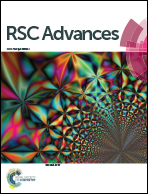Relationship between crosslinking structure and low dielectric constant of hydrophobic epoxies based on substituted biphenyl mesogenic units
Abstract
In this work, a series of low dielectric constant hydrophobic epoxies based on substituted biphenyl mesogenic were prepared and characterized. The liquid crystalline phase structure and the crosslink density of substituted biphenyl epoxies were determined by polarized optical microscopy, wide angle X-ray diffraction measurements and dynamic storage moduli data. Relationship between crosslinking structure and dielectric and water resistance properties was discussed in our paper. The samples showed lower dielectric constants down to 2.24, owing to the oriented structure and increased crosslink network density caused by the orientation of biphenyl mesogenic, indicating a new idea to prepare low dielectric constant epoxies by introducing the mesogenic units into epoxy resins. And the comprehensive contributions of oriented structure and increased crosslink network in epoxies cured by aromatic amines, less hydroxyl groups existing in epoxies cured with anhydride and the hydrophobic methyl substituents or larger tert-butyl substituents, could afford good water resistance properties with water absorptions during 48 h at 25 °C ranging from 0.31–0.36%, which indicated that the water resistance was apparently better than that of conventional epoxy systems.


 Please wait while we load your content...
Please wait while we load your content...